Tax Law Assignment: Case Studies on Income Tax Assessment Act 1997
VerifiedAdded on 2020/04/07
|10
|1456
|49
Homework Assignment
AI Summary
This document presents a comprehensive solution to a tax assignment, addressing several key issues within Australian tax law. The assignment analyzes the tax implications of capital gains and losses from the sale of assets, specifically focusing on the provisions of the Income Tax Assessment Act 1997 (ITAA 1997). It explores scenarios involving personally used assets and the limitations on claiming losses. The assignment also examines the treatment of fringe benefits tax (FBT) and the impact of Taxation Rulings, such as TR 93/6, on loan arrangements. Furthermore, it delves into the allocation of losses in joint rental properties, referencing TR 93/32 and relevant case law. The assignment also discusses the concept of tax avoidance, using the IRC v Duke of Westminster case as a reference point. Finally, the assignment addresses the treatment of income from the sale of felled timber, referencing section 6-1 of the ITAA 1936 and the TR 95/6 ruling. Each question is addressed with a detailed issue, rules, application and conclusion section.
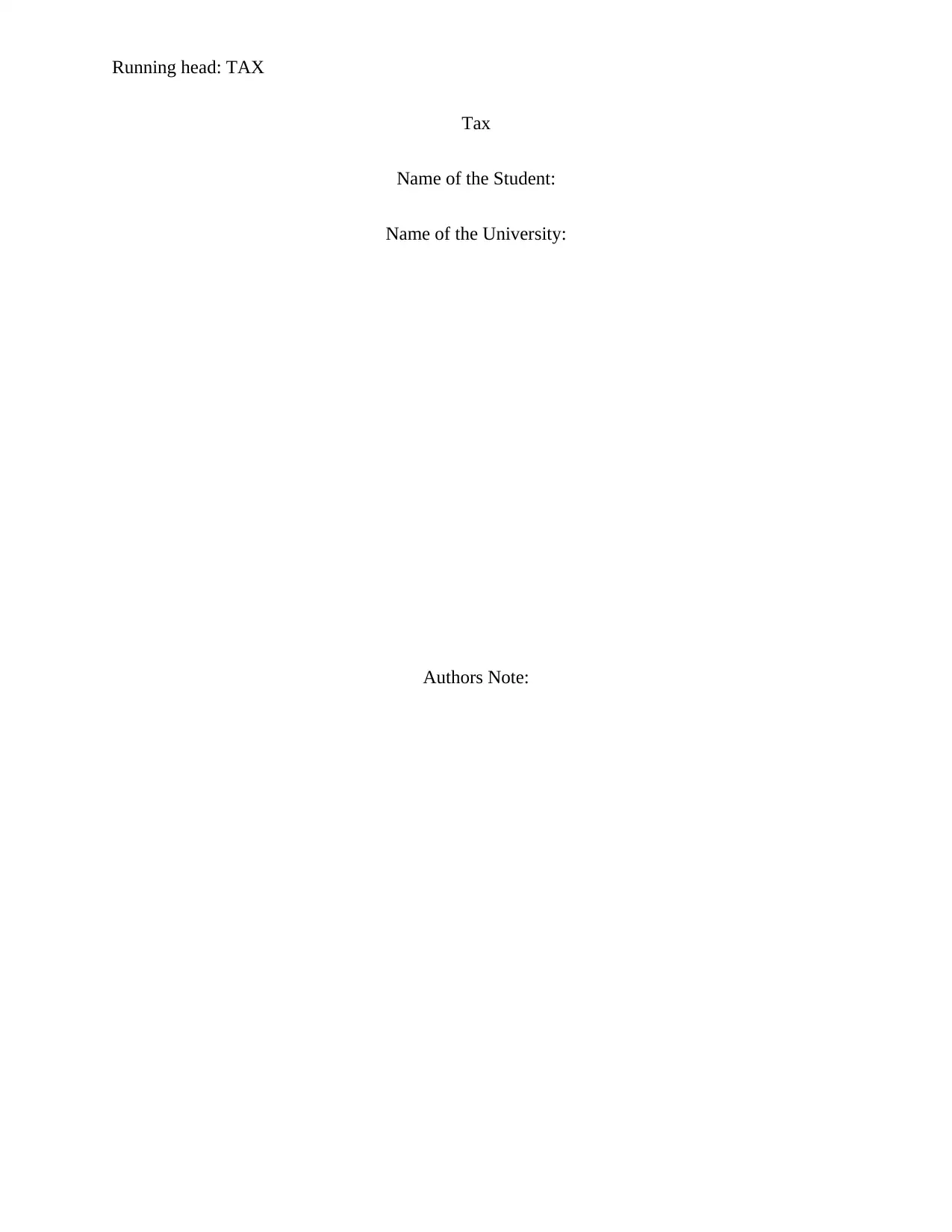
Running head: TAX
Tax
Name of the Student:
Name of the University:
Authors Note:
Tax
Name of the Student:
Name of the University:
Authors Note:
Paraphrase This Document
Need a fresh take? Get an instant paraphrase of this document with our AI Paraphraser
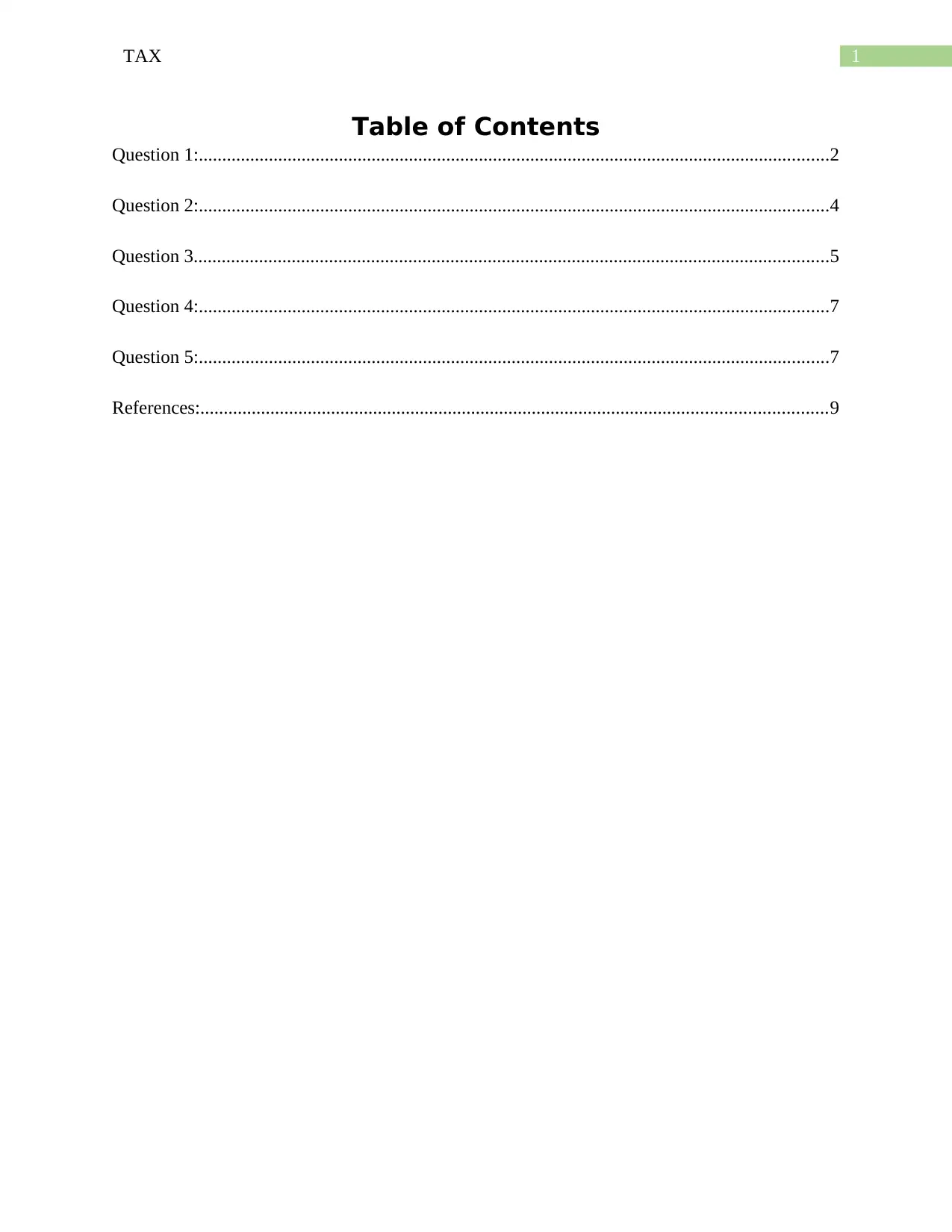
1TAX
Table of Contents
Question 1:.......................................................................................................................................2
Question 2:.......................................................................................................................................4
Question 3........................................................................................................................................5
Question 4:.......................................................................................................................................7
Question 5:.......................................................................................................................................7
References:......................................................................................................................................9
Table of Contents
Question 1:.......................................................................................................................................2
Question 2:.......................................................................................................................................4
Question 3........................................................................................................................................5
Question 4:.......................................................................................................................................7
Question 5:.......................................................................................................................................7
References:......................................................................................................................................9
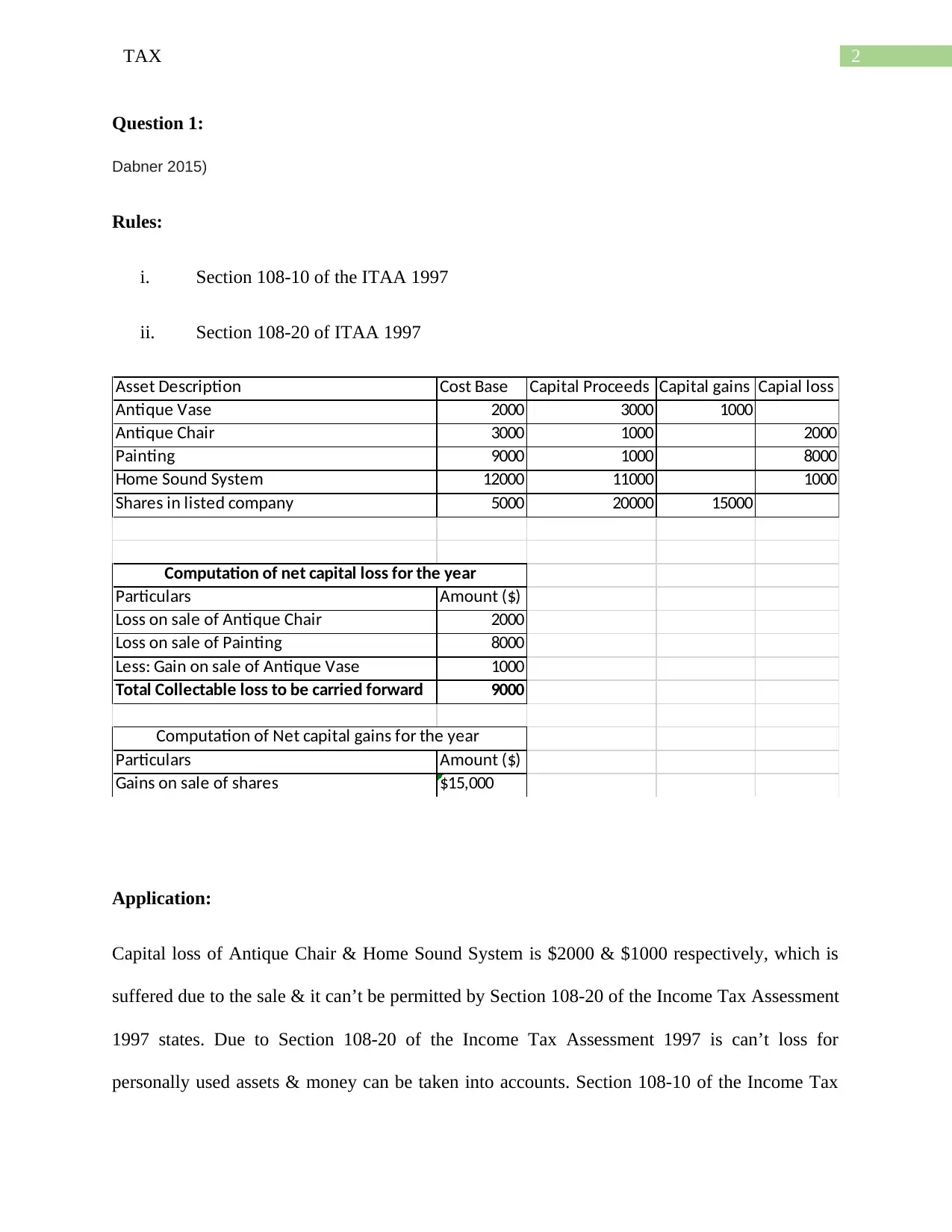
2TAX
Question 1:
Dabner 2015)
Rules:
i. Section 108-10 of the ITAA 1997
ii. Section 108-20 of ITAA 1997
Asset Description Cost Base Capital Proceeds Capital gains Capial loss
Antique Vase 2000 3000 1000
Antique Chair 3000 1000 2000
Painting 9000 1000 8000
Home Sound System 12000 11000 1000
Shares in listed company 5000 20000 15000
Particulars Amount ($)
Loss on sale of Antique Chair 2000
Loss on sale of Painting 8000
Less: Gain on sale of Antique Vase 1000
Total Collectable loss to be carried forward 9000
Particulars Amount ($)
Gains on sale of shares $15,000
Computation of net capital loss for the year
Computation of Net capital gains for the year
Application:
Capital loss of Antique Chair & Home Sound System is $2000 & $1000 respectively, which is
suffered due to the sale & it can’t be permitted by Section 108-20 of the Income Tax Assessment
1997 states. Due to Section 108-20 of the Income Tax Assessment 1997 is can’t loss for
personally used assets & money can be taken into accounts. Section 108-10 of the Income Tax
Question 1:
Dabner 2015)
Rules:
i. Section 108-10 of the ITAA 1997
ii. Section 108-20 of ITAA 1997
Asset Description Cost Base Capital Proceeds Capital gains Capial loss
Antique Vase 2000 3000 1000
Antique Chair 3000 1000 2000
Painting 9000 1000 8000
Home Sound System 12000 11000 1000
Shares in listed company 5000 20000 15000
Particulars Amount ($)
Loss on sale of Antique Chair 2000
Loss on sale of Painting 8000
Less: Gain on sale of Antique Vase 1000
Total Collectable loss to be carried forward 9000
Particulars Amount ($)
Gains on sale of shares $15,000
Computation of net capital loss for the year
Computation of Net capital gains for the year
Application:
Capital loss of Antique Chair & Home Sound System is $2000 & $1000 respectively, which is
suffered due to the sale & it can’t be permitted by Section 108-20 of the Income Tax Assessment
1997 states. Due to Section 108-20 of the Income Tax Assessment 1997 is can’t loss for
personally used assets & money can be taken into accounts. Section 108-10 of the Income Tax
⊘ This is a preview!⊘
Do you want full access?
Subscribe today to unlock all pages.

Trusted by 1+ million students worldwide
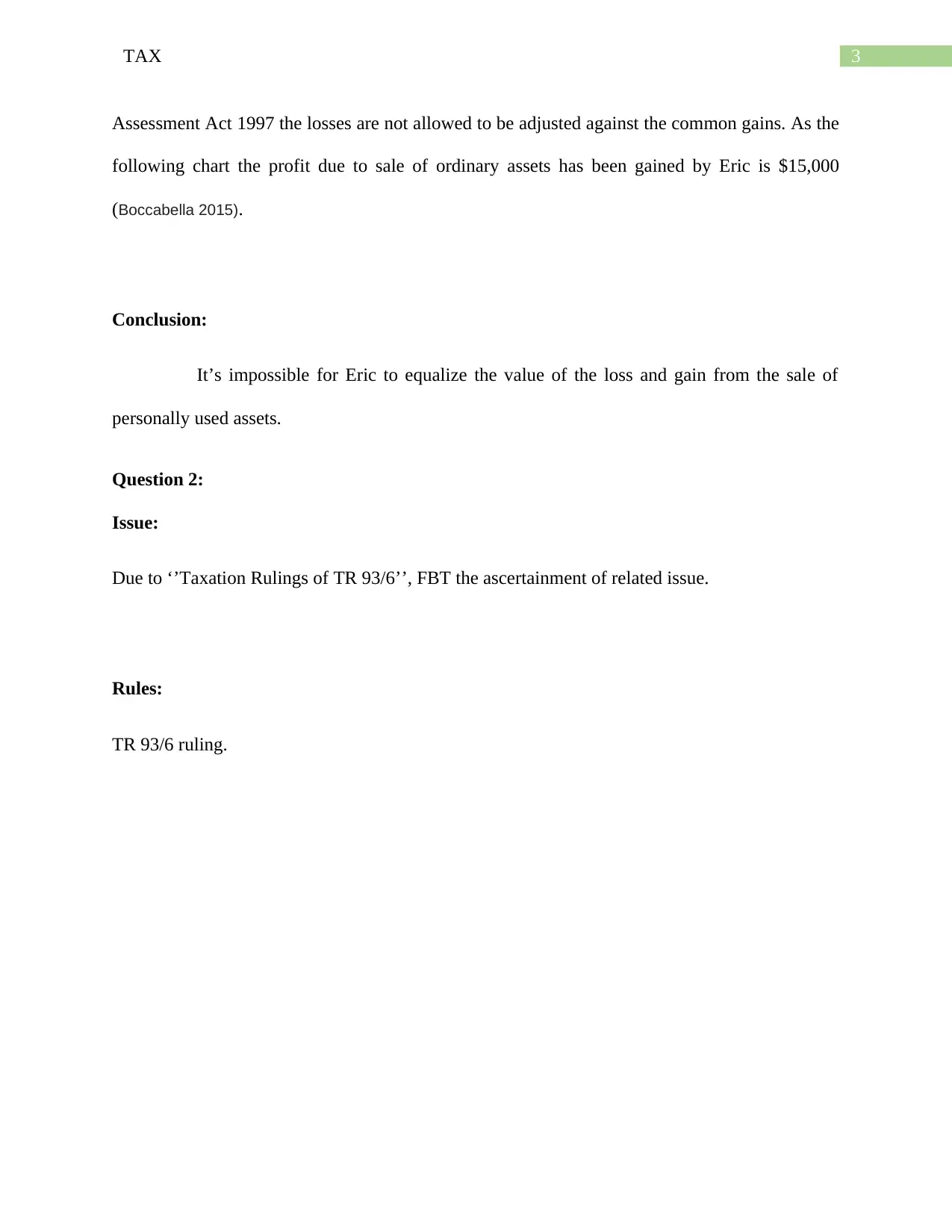
3TAX
Assessment Act 1997 the losses are not allowed to be adjusted against the common gains. As the
following chart the profit due to sale of ordinary assets has been gained by Eric is $15,000
(Boccabella 2015).
Conclusion:
It’s impossible for Eric to equalize the value of the loss and gain from the sale of
personally used assets.
Question 2:
Issue:
Due to ‘’Taxation Rulings of TR 93/6’’, FBT the ascertainment of related issue.
Rules:
TR 93/6 ruling.
Assessment Act 1997 the losses are not allowed to be adjusted against the common gains. As the
following chart the profit due to sale of ordinary assets has been gained by Eric is $15,000
(Boccabella 2015).
Conclusion:
It’s impossible for Eric to equalize the value of the loss and gain from the sale of
personally used assets.
Question 2:
Issue:
Due to ‘’Taxation Rulings of TR 93/6’’, FBT the ascertainment of related issue.
Rules:
TR 93/6 ruling.
Paraphrase This Document
Need a fresh take? Get an instant paraphrase of this document with our AI Paraphraser
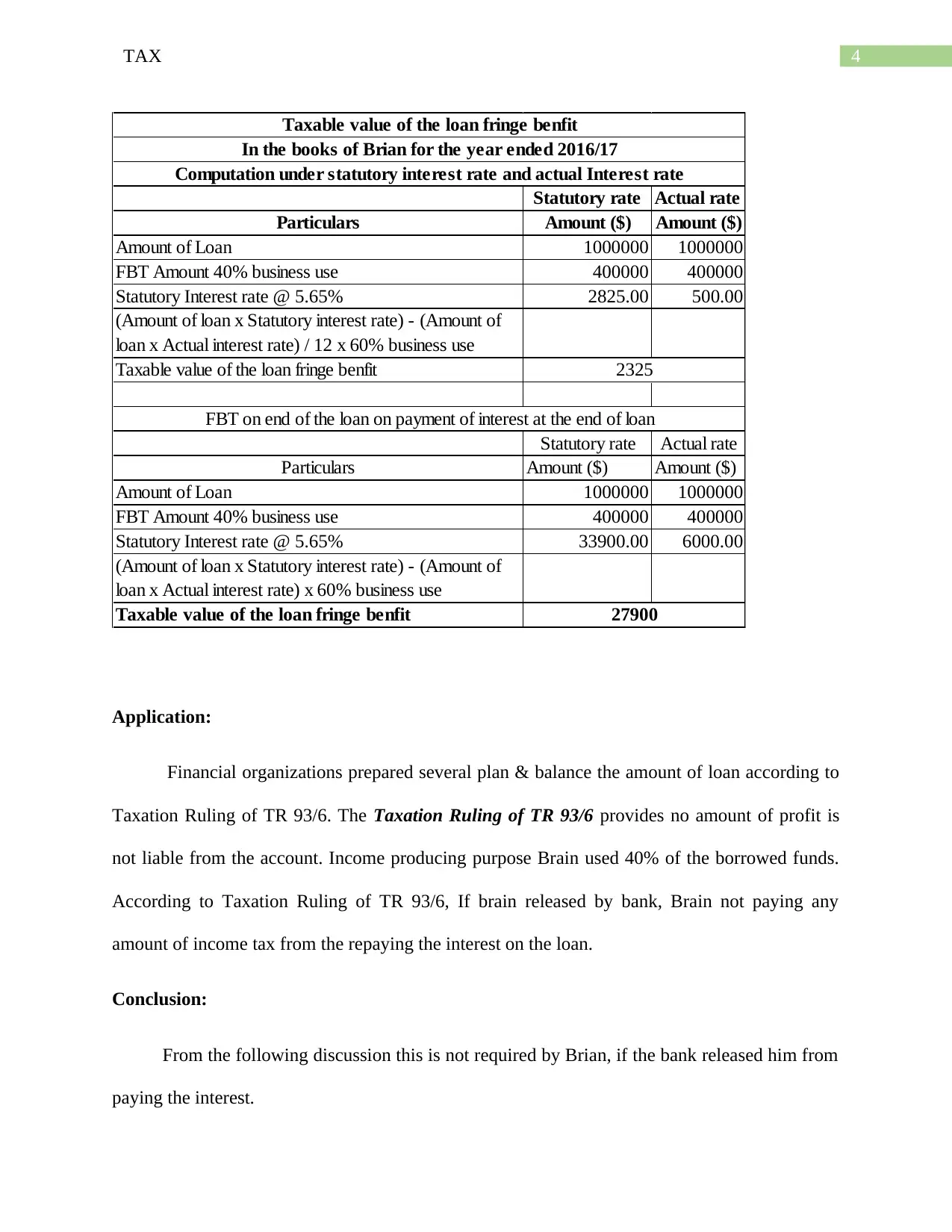
4TAX
Statutory rate Actual rate
Particulars Amount ($) Amount ($)
Amount of Loan 1000000 1000000
FBT Amount 40% business use 400000 400000
Statutory Interest rate @ 5.65% 2825.00 500.00
(Amount of loan x Statutory interest rate) - (Amount of
loan x Actual interest rate) / 12 x 60% business use
Taxable value of the loan fringe benfit
Statutory rate Actual rate
Particulars Amount ($) Amount ($)
Amount of Loan 1000000 1000000
FBT Amount 40% business use 400000 400000
Statutory Interest rate @ 5.65% 33900.00 6000.00
(Amount of loan x Statutory interest rate) - (Amount of
loan x Actual interest rate) x 60% business use
Taxable value of the loan fringe benfit
2325
27900
FBT on end of the loan on payment of interest at the end of loan
Taxable value of the loan fringe benfit
In the books of Brian for the year ended 2016/17
Computation under statutory interest rate and actual Interest rate
Application:
Financial organizations prepared several plan & balance the amount of loan according to
Taxation Ruling of TR 93/6. The Taxation Ruling of TR 93/6 provides no amount of profit is
not liable from the account. Income producing purpose Brain used 40% of the borrowed funds.
According to Taxation Ruling of TR 93/6, If brain released by bank, Brain not paying any
amount of income tax from the repaying the interest on the loan.
Conclusion:
From the following discussion this is not required by Brian, if the bank released him from
paying the interest.
Statutory rate Actual rate
Particulars Amount ($) Amount ($)
Amount of Loan 1000000 1000000
FBT Amount 40% business use 400000 400000
Statutory Interest rate @ 5.65% 2825.00 500.00
(Amount of loan x Statutory interest rate) - (Amount of
loan x Actual interest rate) / 12 x 60% business use
Taxable value of the loan fringe benfit
Statutory rate Actual rate
Particulars Amount ($) Amount ($)
Amount of Loan 1000000 1000000
FBT Amount 40% business use 400000 400000
Statutory Interest rate @ 5.65% 33900.00 6000.00
(Amount of loan x Statutory interest rate) - (Amount of
loan x Actual interest rate) x 60% business use
Taxable value of the loan fringe benfit
2325
27900
FBT on end of the loan on payment of interest at the end of loan
Taxable value of the loan fringe benfit
In the books of Brian for the year ended 2016/17
Computation under statutory interest rate and actual Interest rate
Application:
Financial organizations prepared several plan & balance the amount of loan according to
Taxation Ruling of TR 93/6. The Taxation Ruling of TR 93/6 provides no amount of profit is
not liable from the account. Income producing purpose Brain used 40% of the borrowed funds.
According to Taxation Ruling of TR 93/6, If brain released by bank, Brain not paying any
amount of income tax from the repaying the interest on the loan.
Conclusion:
From the following discussion this is not required by Brian, if the bank released him from
paying the interest.
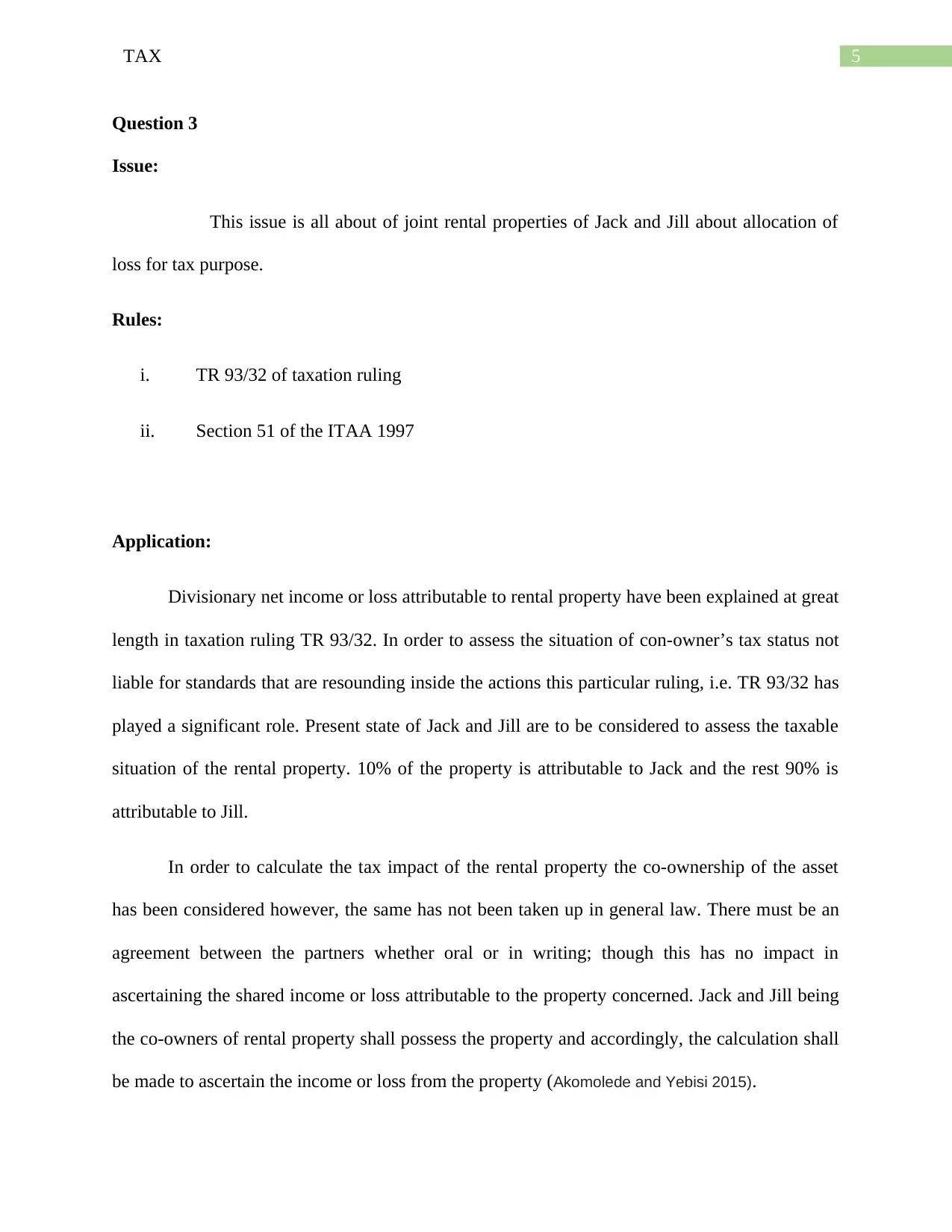
5TAX
Question 3
Issue:
This issue is all about of joint rental properties of Jack and Jill about allocation of
loss for tax purpose.
Rules:
i. TR 93/32 of taxation ruling
ii. Section 51 of the ITAA 1997
Application:
Divisionary net income or loss attributable to rental property have been explained at great
length in taxation ruling TR 93/32. In order to assess the situation of con-owner’s tax status not
liable for standards that are resounding inside the actions this particular ruling, i.e. TR 93/32 has
played a significant role. Present state of Jack and Jill are to be considered to assess the taxable
situation of the rental property. 10% of the property is attributable to Jack and the rest 90% is
attributable to Jill.
In order to calculate the tax impact of the rental property the co-ownership of the asset
has been considered however, the same has not been taken up in general law. There must be an
agreement between the partners whether oral or in writing; though this has no impact in
ascertaining the shared income or loss attributable to the property concerned. Jack and Jill being
the co-owners of rental property shall possess the property and accordingly, the calculation shall
be made to ascertain the income or loss from the property (Akomolede and Yebisi 2015).
Question 3
Issue:
This issue is all about of joint rental properties of Jack and Jill about allocation of
loss for tax purpose.
Rules:
i. TR 93/32 of taxation ruling
ii. Section 51 of the ITAA 1997
Application:
Divisionary net income or loss attributable to rental property have been explained at great
length in taxation ruling TR 93/32. In order to assess the situation of con-owner’s tax status not
liable for standards that are resounding inside the actions this particular ruling, i.e. TR 93/32 has
played a significant role. Present state of Jack and Jill are to be considered to assess the taxable
situation of the rental property. 10% of the property is attributable to Jack and the rest 90% is
attributable to Jill.
In order to calculate the tax impact of the rental property the co-ownership of the asset
has been considered however, the same has not been taken up in general law. There must be an
agreement between the partners whether oral or in writing; though this has no impact in
ascertaining the shared income or loss attributable to the property concerned. Jack and Jill being
the co-owners of rental property shall possess the property and accordingly, the calculation shall
be made to ascertain the income or loss from the property (Akomolede and Yebisi 2015).
⊘ This is a preview!⊘
Do you want full access?
Subscribe today to unlock all pages.

Trusted by 1+ million students worldwide
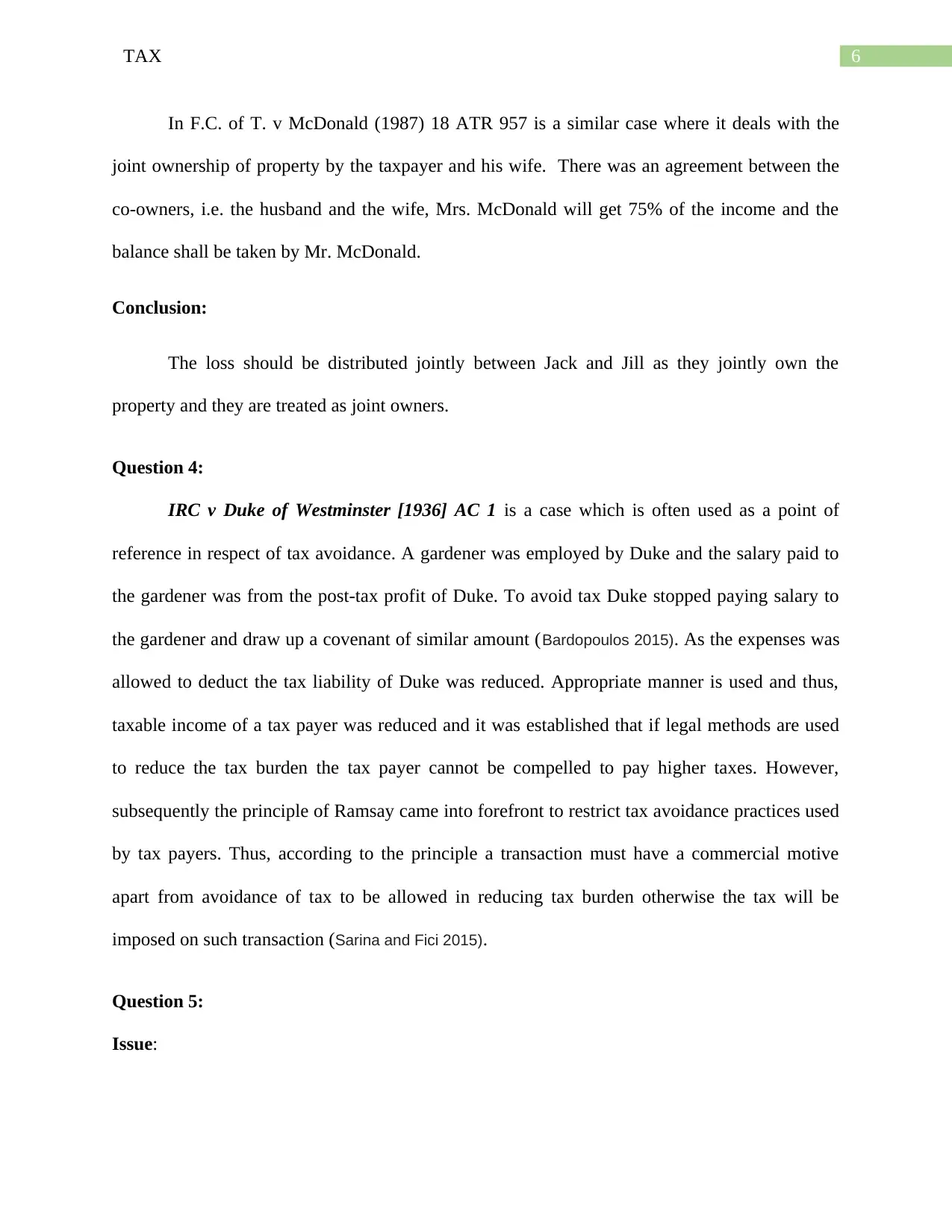
6TAX
In F.C. of T. v McDonald (1987) 18 ATR 957 is a similar case where it deals with the
joint ownership of property by the taxpayer and his wife. There was an agreement between the
co-owners, i.e. the husband and the wife, Mrs. McDonald will get 75% of the income and the
balance shall be taken by Mr. McDonald.
Conclusion:
The loss should be distributed jointly between Jack and Jill as they jointly own the
property and they are treated as joint owners.
Question 4:
IRC v Duke of Westminster [1936] AC 1 is a case which is often used as a point of
reference in respect of tax avoidance. A gardener was employed by Duke and the salary paid to
the gardener was from the post-tax profit of Duke. To avoid tax Duke stopped paying salary to
the gardener and draw up a covenant of similar amount (Bardopoulos 2015). As the expenses was
allowed to deduct the tax liability of Duke was reduced. Appropriate manner is used and thus,
taxable income of a tax payer was reduced and it was established that if legal methods are used
to reduce the tax burden the tax payer cannot be compelled to pay higher taxes. However,
subsequently the principle of Ramsay came into forefront to restrict tax avoidance practices used
by tax payers. Thus, according to the principle a transaction must have a commercial motive
apart from avoidance of tax to be allowed in reducing tax burden otherwise the tax will be
imposed on such transaction (Sarina and Fici 2015).
Question 5:
Issue:
In F.C. of T. v McDonald (1987) 18 ATR 957 is a similar case where it deals with the
joint ownership of property by the taxpayer and his wife. There was an agreement between the
co-owners, i.e. the husband and the wife, Mrs. McDonald will get 75% of the income and the
balance shall be taken by Mr. McDonald.
Conclusion:
The loss should be distributed jointly between Jack and Jill as they jointly own the
property and they are treated as joint owners.
Question 4:
IRC v Duke of Westminster [1936] AC 1 is a case which is often used as a point of
reference in respect of tax avoidance. A gardener was employed by Duke and the salary paid to
the gardener was from the post-tax profit of Duke. To avoid tax Duke stopped paying salary to
the gardener and draw up a covenant of similar amount (Bardopoulos 2015). As the expenses was
allowed to deduct the tax liability of Duke was reduced. Appropriate manner is used and thus,
taxable income of a tax payer was reduced and it was established that if legal methods are used
to reduce the tax burden the tax payer cannot be compelled to pay higher taxes. However,
subsequently the principle of Ramsay came into forefront to restrict tax avoidance practices used
by tax payers. Thus, according to the principle a transaction must have a commercial motive
apart from avoidance of tax to be allowed in reducing tax burden otherwise the tax will be
imposed on such transaction (Sarina and Fici 2015).
Question 5:
Issue:
Paraphrase This Document
Need a fresh take? Get an instant paraphrase of this document with our AI Paraphraser
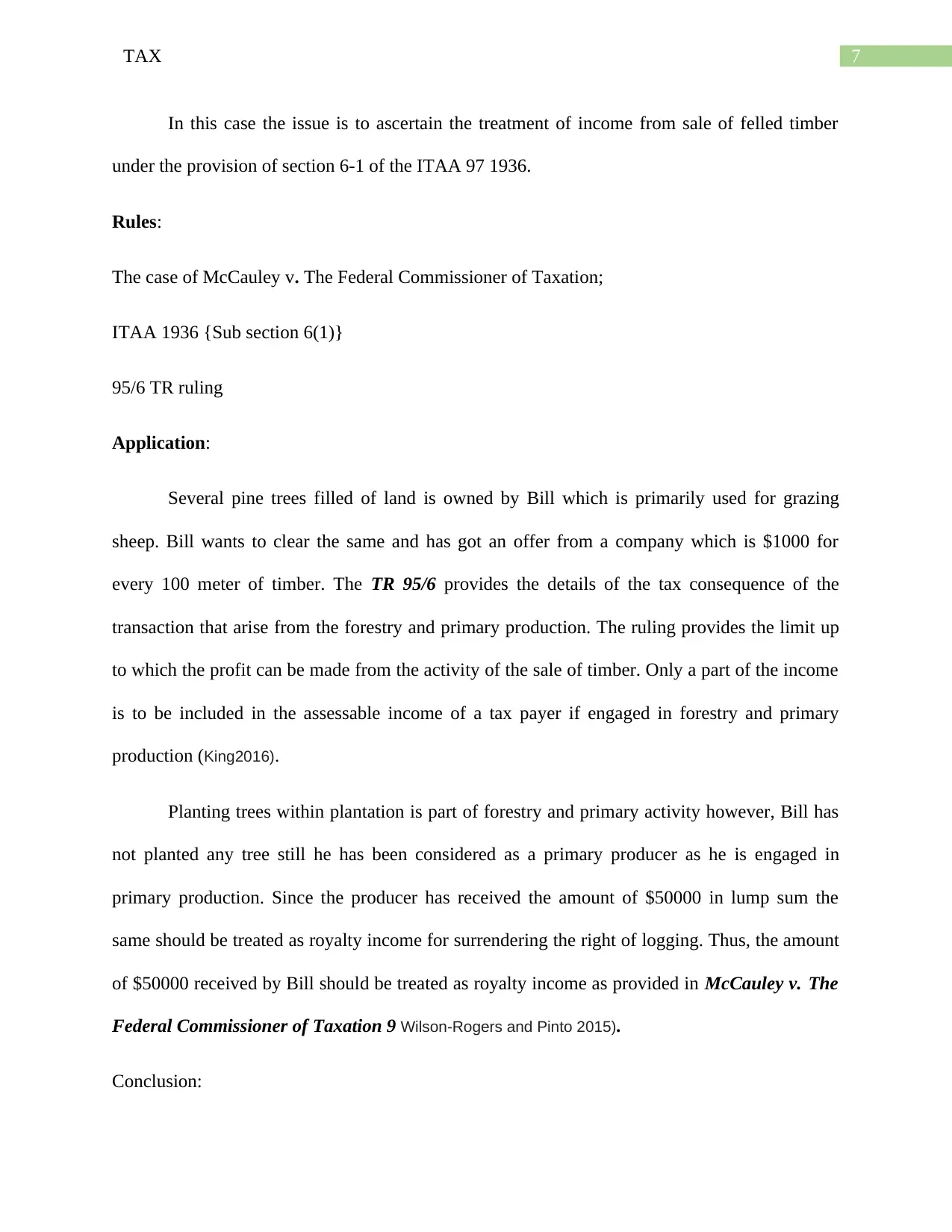
7TAX
In this case the issue is to ascertain the treatment of income from sale of felled timber
under the provision of section 6-1 of the ITAA 97 1936.
Rules:
The case of McCauley v. The Federal Commissioner of Taxation;
ITAA 1936 {Sub section 6(1)}
95/6 TR ruling
Application:
Several pine trees filled of land is owned by Bill which is primarily used for grazing
sheep. Bill wants to clear the same and has got an offer from a company which is $1000 for
every 100 meter of timber. The TR 95/6 provides the details of the tax consequence of the
transaction that arise from the forestry and primary production. The ruling provides the limit up
to which the profit can be made from the activity of the sale of timber. Only a part of the income
is to be included in the assessable income of a tax payer if engaged in forestry and primary
production (King2016).
Planting trees within plantation is part of forestry and primary activity however, Bill has
not planted any tree still he has been considered as a primary producer as he is engaged in
primary production. Since the producer has received the amount of $50000 in lump sum the
same should be treated as royalty income for surrendering the right of logging. Thus, the amount
of $50000 received by Bill should be treated as royalty income as provided in McCauley v. The
Federal Commissioner of Taxation 9 Wilson-Rogers and Pinto 2015).
Conclusion:
In this case the issue is to ascertain the treatment of income from sale of felled timber
under the provision of section 6-1 of the ITAA 97 1936.
Rules:
The case of McCauley v. The Federal Commissioner of Taxation;
ITAA 1936 {Sub section 6(1)}
95/6 TR ruling
Application:
Several pine trees filled of land is owned by Bill which is primarily used for grazing
sheep. Bill wants to clear the same and has got an offer from a company which is $1000 for
every 100 meter of timber. The TR 95/6 provides the details of the tax consequence of the
transaction that arise from the forestry and primary production. The ruling provides the limit up
to which the profit can be made from the activity of the sale of timber. Only a part of the income
is to be included in the assessable income of a tax payer if engaged in forestry and primary
production (King2016).
Planting trees within plantation is part of forestry and primary activity however, Bill has
not planted any tree still he has been considered as a primary producer as he is engaged in
primary production. Since the producer has received the amount of $50000 in lump sum the
same should be treated as royalty income for surrendering the right of logging. Thus, the amount
of $50000 received by Bill should be treated as royalty income as provided in McCauley v. The
Federal Commissioner of Taxation 9 Wilson-Rogers and Pinto 2015).
Conclusion:

8TAX
The assessable income of Bill has to include the lump sum payment received by him as
royalty.
The assessable income of Bill has to include the lump sum payment received by him as
royalty.
⊘ This is a preview!⊘
Do you want full access?
Subscribe today to unlock all pages.

Trusted by 1+ million students worldwide
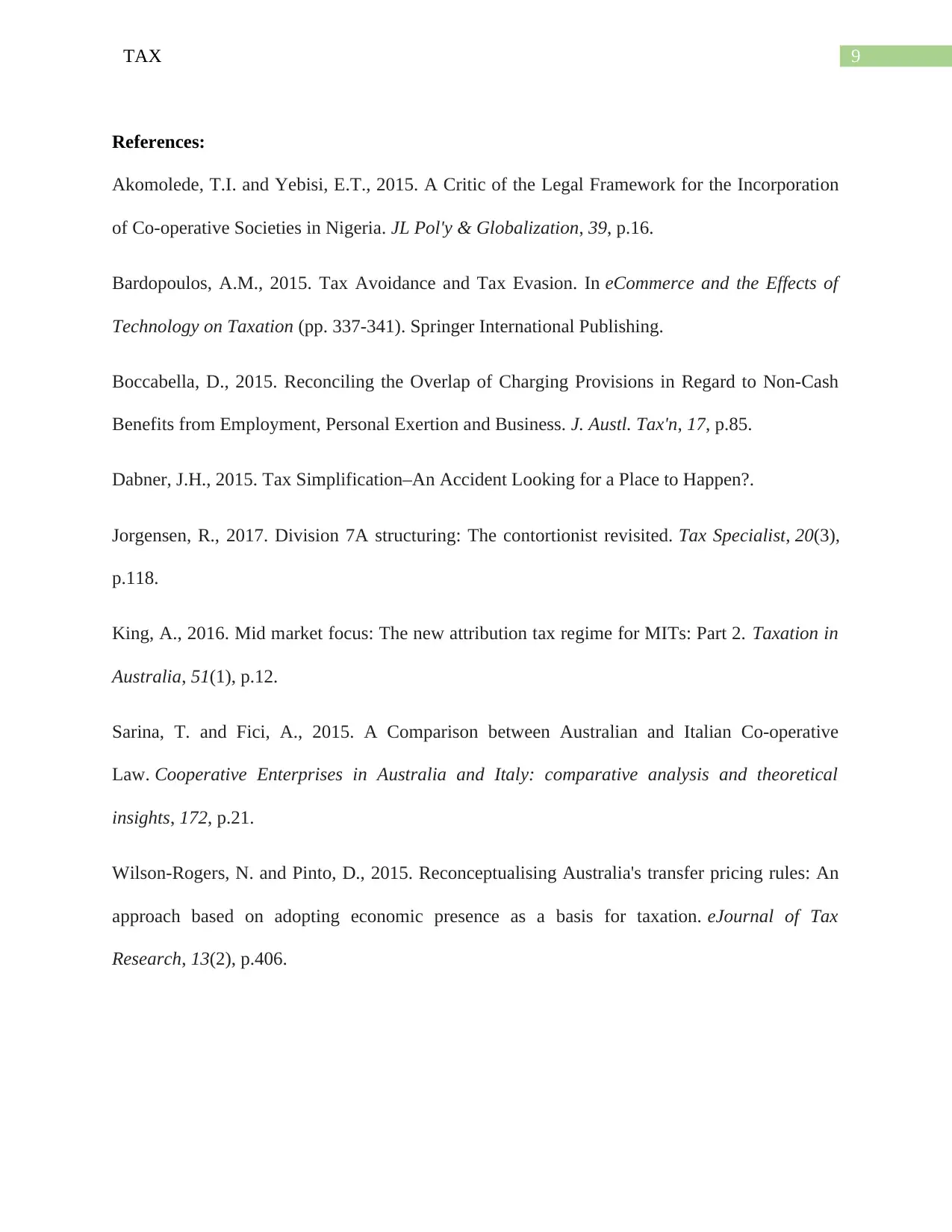
9TAX
References:
Akomolede, T.I. and Yebisi, E.T., 2015. A Critic of the Legal Framework for the Incorporation
of Co-operative Societies in Nigeria. JL Pol'y & Globalization, 39, p.16.
Bardopoulos, A.M., 2015. Tax Avoidance and Tax Evasion. In eCommerce and the Effects of
Technology on Taxation (pp. 337-341). Springer International Publishing.
Boccabella, D., 2015. Reconciling the Overlap of Charging Provisions in Regard to Non-Cash
Benefits from Employment, Personal Exertion and Business. J. Austl. Tax'n, 17, p.85.
Dabner, J.H., 2015. Tax Simplification–An Accident Looking for a Place to Happen?.
Jorgensen, R., 2017. Division 7A structuring: The contortionist revisited. Tax Specialist, 20(3),
p.118.
King, A., 2016. Mid market focus: The new attribution tax regime for MITs: Part 2. Taxation in
Australia, 51(1), p.12.
Sarina, T. and Fici, A., 2015. A Comparison between Australian and Italian Co-operative
Law. Cooperative Enterprises in Australia and Italy: comparative analysis and theoretical
insights, 172, p.21.
Wilson-Rogers, N. and Pinto, D., 2015. Reconceptualising Australia's transfer pricing rules: An
approach based on adopting economic presence as a basis for taxation. eJournal of Tax
Research, 13(2), p.406.
References:
Akomolede, T.I. and Yebisi, E.T., 2015. A Critic of the Legal Framework for the Incorporation
of Co-operative Societies in Nigeria. JL Pol'y & Globalization, 39, p.16.
Bardopoulos, A.M., 2015. Tax Avoidance and Tax Evasion. In eCommerce and the Effects of
Technology on Taxation (pp. 337-341). Springer International Publishing.
Boccabella, D., 2015. Reconciling the Overlap of Charging Provisions in Regard to Non-Cash
Benefits from Employment, Personal Exertion and Business. J. Austl. Tax'n, 17, p.85.
Dabner, J.H., 2015. Tax Simplification–An Accident Looking for a Place to Happen?.
Jorgensen, R., 2017. Division 7A structuring: The contortionist revisited. Tax Specialist, 20(3),
p.118.
King, A., 2016. Mid market focus: The new attribution tax regime for MITs: Part 2. Taxation in
Australia, 51(1), p.12.
Sarina, T. and Fici, A., 2015. A Comparison between Australian and Italian Co-operative
Law. Cooperative Enterprises in Australia and Italy: comparative analysis and theoretical
insights, 172, p.21.
Wilson-Rogers, N. and Pinto, D., 2015. Reconceptualising Australia's transfer pricing rules: An
approach based on adopting economic presence as a basis for taxation. eJournal of Tax
Research, 13(2), p.406.
1 out of 10
Related Documents
Your All-in-One AI-Powered Toolkit for Academic Success.
+13062052269
info@desklib.com
Available 24*7 on WhatsApp / Email
![[object Object]](/_next/static/media/star-bottom.7253800d.svg)
Unlock your academic potential
Copyright © 2020–2025 A2Z Services. All Rights Reserved. Developed and managed by ZUCOL.
![Taxation Law Analysis Assignment - [University Name]](/_next/image/?url=https%3A%2F%2Fdesklib.com%2Fmedia%2Fimages%2F237a5b831ee046ecb975c30288c0819d.jpg&w=256&q=75)




